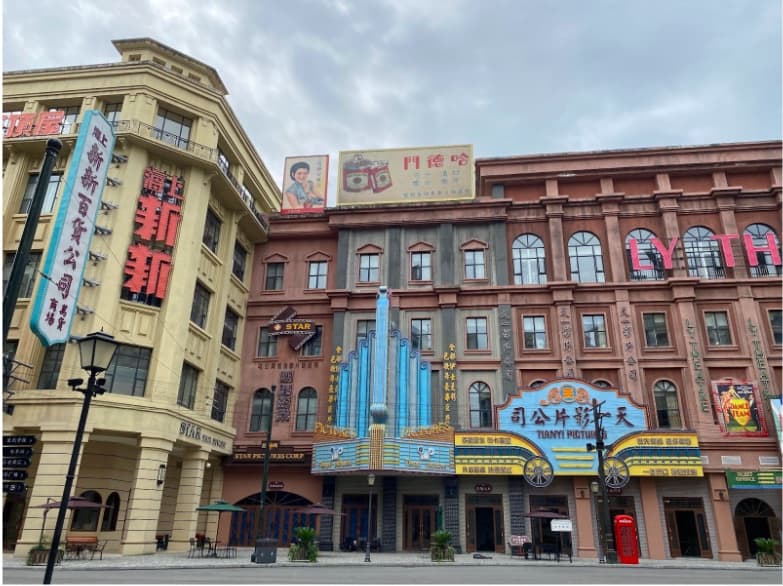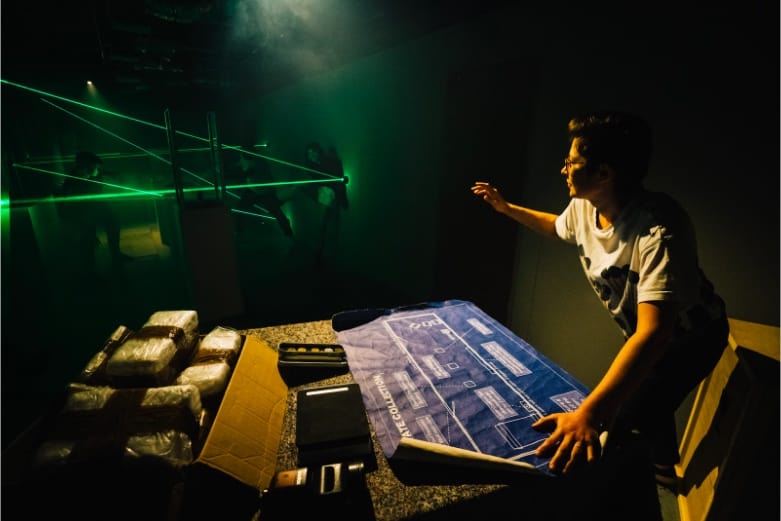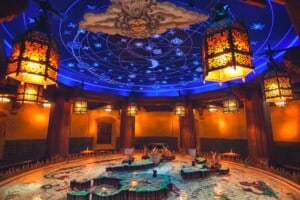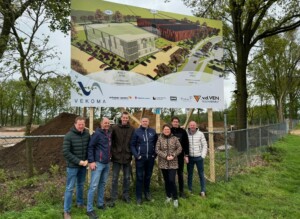In Part 4 of their conversation about interactive narrative experiences, Raven Sun Creative’s Louis Alfieri and Tim Madison look at interactive storytelling through the lens of “narrative architecture”.
The shared spaces of game design and LBE experiential storytelling
Louis Alfieri: Game design and location-based experiential design, share a lot of the same or overlapping challenges and considerations. We are all spatial designers. Virtual space is being used to express and or simulate a physical space.
In our last discussion, we talked about different types of branching tree narrative structures where the participant’s choices determine how the story unfolds. It’s fair to say that those kinds of structures underlie the vast majority of interactive narratives, particularly in gaming.
Tim Madison: Any experience with a pre-written variable plot that asks the participant to choose their path is going to involve that kind of decision tree structure by necessity.

LA: That’s one way to look at creating interactive narrative–in terms of plot mechanics. This time around, I want to look at the subject through a slightly different lens. It’s a topic you raised previously, Tim: thinking of different categories of interactive narrative as types of spaces or architecture.
TM: Right, that’s an idea that was advanced by the media scholar Henry Jenkins in his essay “Game Design as Narrative Architecture.” Jenkins just takes a broader view of what narrative is, taking into account storytelling methods that include, and also go beyond scripted plotlines. I would not say that this is meant as an alternative to branching narrative, as that interactive storytelling structure can certainly fit into his concept.
Narratively compelling spaces
TM: Jenkins describes interactive narrative as a series of narratively compelling spaces that the player travels through. He’s talking specifically about video games, yet it’s an idea that applies readily to location-based experiences.
It looks at interactive stories as different kinds of narrative environments. They are essentially varying types of story playgrounds that enable us to “play” in different ways. Story is the result of how we play in that interactive space. In that sense, virtual video game space and real-world space aren’t so different.
Story is the result of how we play in that interactive space
LA: That’s a useful way of thinking about what we do. As designers, we are using the virtual and real-world space–literally, symbolically, and programmatically–to frame, cue, and support a wide range of responses and interactions.
We use movement, light, sound, cause and effect, reward, and so forth to create conditions and spaces for human experience. Whether it’s virtual or physical or a combination of both, we make sense of the world in the same way.
TM: Right, our sense of how time and space work is consistent whether the world we’re inhabiting is digital or physical. We’re judging by the same standards. That’s why Jenkins’ classifications carry over so well to immersive experiences in the real world. In both cases, we’re talking about participants moving through and interacting with designed environments.
The models Jenkins describes can be standalone approaches or used in combination with one another. Game and experience designers are usually working in more than one category if not all of them.
For instance, an escape room experience may use a blend of evocative, enacted, and embedded narrative architecture. There’s value, though, in understanding each of these categories in isolation. Let’s take a look at Jenkin’s Models…
Jenkins’ Models of Narrative Architecture
Evocative narrative architecture
Evocative narrative architecture draws upon the audience’s collective memories, knowledge, and understanding of an existing genre, style, or IP through environmental design.

The environments use familiar elements and sensory tropes to suggest rich narrative potential–without necessarily resorting to plot or linear storytelling. This method can be used to play with participants’ expectations, subverting or fulfilling them depending upon the desired effect.
Common to both game and location-based entertainment design, evocative narrative is the form we most commonly associate with the notion of “theming”.
Examples:
- Fallout game series blends post-apocalyptic science fiction with 1950s-style Americana
- Star Wars: Galaxy’s Edge
- The Wizarding World of Harry Potter
- Europa-Park’s country-themed lands
- Secret Cinema’s Blade Runner event
Enacted narrative architecture
Enacted narrative architecture provides a structure in which a participant can explore, experience, and perform the actions of the story. The participant moves through a series of these environments that together form a larger narrative journey, encountering both obstacles and aid along the way.
Unlike a classical static narrative, in which every moment serves plot development, an enacted narrative allows space for the experience of doing within the parameters of a story structure.
Examples:
- Elder Scrolls V: Skyrim
- Red Dead Redemption
- Half-Life: Alyx (VR game)
- Star Wars: Squadrons (VR game)
- The Perfect Crime (hybrid immersive theatre-escape room experience)
Embedded narrative architecture
Embedded narrative architecture takes a form similar to a detective story. The environments contain information that must be discovered by the participant and pieced together to form a larger picture.

The embedded narrative experience is composed of two major elements: the plot and the story. That larger picture–the mystery or lore waiting to be uncovered–is the static plot crafted by the experience creators and embedded in various locations throughout the narrative. The actual story, however, is the journey participants take to solve the mystery.
Examples:
- Myst
- Sherlock Holmes: Crimes and Punishment
- Witcher 3: Wild Hunt (clue and lore-gathering aspects)
- Sleep No More (immersive theatre with clue and detail-rich environments to explore)
Emergent narrative architecture
Emergent narrative architecture describes sandbox or dollhouse-style environments which enable participants to create and live their own stories. The experience spaces provide participants with the tools, building blocks, mechanics, and “living” environments with non-player controlled conditions.

The spaces are invested with potential for the generation of stories that are not predetermined by the designers or constrained by a larger narrative shape. Story flows out of the interaction between participant and the environment.
Examples:
- The Sims
- Minecraft
- Dwarf Fortress
- AI Dungeon
- Live Action Role-playing (LARPing)
The space for possibilities
TM: What I find particularly valuable about Jenkins’ classifications is that they get us thinking about how we create interactive stories for participants. As a writer or designer, it’s easy to jump into the what before you’ve asked some of the more fundamental questions.
The goal is to build a world of potential where the participant can be the driving force of the story
There is sometimes a tendency for storytellers to slip into delivering content over choice and relegating the participant to a less active role. Thinking about story as these sorts of participatory spaces keeps you mindful of the fact that you aren’t dictating plot, you’re creating a range of story possibilities.
LA: That’s a good distinction. The goal is to build a world of potential where the participant can be the driving force of the story. There are different ways to go about that. As important as multi-branching storytelling is, there are more tools at our disposal.
The trouble with ‘theming’
LA: If you don’t mind, I’d like to shift gears for just a moment and jump back to that term ‘theming’ or ‘themed entertainment’. It’s a pet peeve of mine.
“Theming” is a pervasive industry word that I really dislike. It puts an emphasis on the cosmetic and the superficial. That’s too narrow and limiting a definition, and I believe it devalues what experience designers do. We do not create experiences by slapping a theme on them.
Experiential design is about creating complex ecosystems for human engagement
Experiential design is about creating complex ecosystems for human engagement. It’s a nexus for such a diversity of technical and creative disciplines, media, and art forms. ‘Theming’ just doesn’t begin to cover it. Sorry for the detour/. Stepping off my soapbox now…
TM: I’m not a big fan of ‘theming’ either. I agree that it always sounds like it describes something that doesn’t go much deeper than the treatment of a facade. Or worse, decorations for a school dance. Language does do a lot to shape perception and attitude, even sometimes unconsciously.
It’s worth dedicating a future conversation to terminology like ‘theming’, as it is important to every single person in the experiential medium.
Sandbox or Open World?
LA: While we’re on the subject of terminology, I also wanted to touch on the term “sandbox” as a way to describe gameplay. I think the word could use some clarification. “Sandbox” sometimes gets used interchangeably with “open-world”, a term we defined in part 2 of this series. I see them as distinct categories.
TM: I do too. That’s turning out to be something of a recurring theme in this series: the ambiguity and lack of consensus around certain terminology. Some people will tell you there’s no difference between open-world and sandbox. I believe there’s a meaningful distinction to be made…
Sandbox describes an emergent narrative experience that provides participants with the creative tools to generate their own stories spontaneously. There aren’t necessarily any imposed or predetermined storylines or even particular objectives. Story comes from interacting creatively with the environment. Minecraft and The Sims are examples.
Open-world, by contrast, describes an experience where the participant can roam a wide-open environment and aren’t forced to visit locations in a particular order.
Sandbox and open-world often co-exist in games. Minecraft and some of the entries in The Sims series fit into both. The terms describe different qualities, though. Again, though, reasonable minds may disagree.
LA: So far in this series we’ve been talking academically, primarily about background and theory, when it comes to interactive narrative experiences. Next time around I’d like to discuss some current examples of location-based narrative in actual practice.
Following this conversation on narrative architecture, join Alfieri and Madison for Part 5 when they discuss the present state of interactive storytelling in LBE and beyond.












